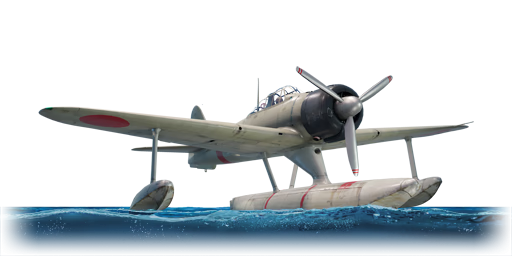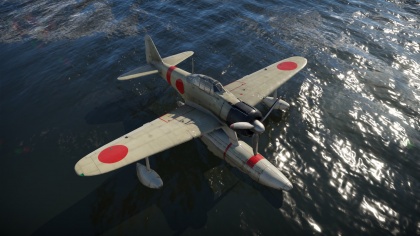A6M2-N
Contents
| This page is about the Japanese fighter A6M2-N. For other versions, see A6M (Family). |
Description
The A6M2-N is a rank II Japanese hydroplane fighter
with a battle rating of 2.7 (AB), 2.3 (RB), and 2.0 (SB). It has been in the game since the start of the Open Beta Test prior to Update 1.27.
Albeit generally worse than the "normal" Zeroes, the A6M2-N still retains good climb rate, acceleration and manoeuvrability. It suffers from bad performance at higher altitudes, but that is rarely a problem for this plane, as high altitude engagements are rare at its battle rating. It also has good armament for such a low battle rating: two 20 mm Type 99 Mod 1 cannons and two 7.7 mm Type 97 machine guns. Although powerful, the guns have low shell velocity, so you should lead your target more than you think. Also, the ammo count is quite low, and the aircraft has no armour or self-sealing fuel tanks, so it is best to avoid taking too many hits, as you will probably start burning from the first 7.5 mm machine gun bullet. The aircraft is designed to land on water, though like all other seaplanes, with enough care, one can land it on airfields.
General info
Flight performance
Describe how the aircraft behaves in the air. Speed, manoeuvrability, acceleration and allowable loads - these are the most important characteristics of the vehicle.
| Characteristics | |||||||
|---|---|---|---|---|---|---|---|
| Stock | |||||||
| Max Speed (km/h at 4,300 m) |
Max altitude (meters) |
Turn time (seconds) |
Rate of climb (meters/second) |
Take-off run (meters) | |||
| AB | RB | AB | RB | AB | RB | ||
| 418 | 408 | 9100 | 20.7 | 21.1 | 9.3 | 9.3 | 500 |
| Upgraded | |||||||
| Max Speed (km/h at 4,300 m) |
Max altitude (meters) |
Turn time (seconds) |
Rate of climb (meters/second) |
Take-off run (meters) | |||
| AB | RB | AB | RB | AB | RB | ||
| 447 | 432 | 9100 | 19.4 | 20.0 | 16.1 | 12.3 | 500 |
Details
| Features | ||||
|---|---|---|---|---|
| Combat flaps | Take-off flaps | Landing flaps | Air brakes | Arrestor gear |
| ✓ | ✓ | ✓ | X | X |
| Limits | ||||
|---|---|---|---|---|
| Wing-break speed (km/h) |
Gear limit (km/h) |
Combat flaps (km/h) |
Max Static G | |
| + | - | |||
| 520 | ~12 | ~10 | ||
| Optimal velocities | |||
|---|---|---|---|
| Ailerons (km/h) |
Rudder (km/h) |
Elevators (km/h) |
Radiator (km/h) |
| < 310 | < 420 | < 410 | > 324 |
| Compressor (RB/SB) | ||
|---|---|---|
| Setting 1 | ||
| Optimal altitude | 100% Engine power | WEP Engine power |
| 3,560 m | 935 hp | 1,055 hp |
Survivability and armour
Examine the survivability of the aircraft. Note how vulnerable the structure is and how secure the pilot is, whether the fuel tanks are armoured, etc. Describe the armour, if there is any, and also mention the vulnerability of other critical aircraft systems.
Armaments
Offensive armament
The A6M2-N is armed with:
- 2 x 20 mm Type 99 Model 1 navy cannons, wing-mounted (60 rpg = 120 total)
- 2 x 7.7 mm Type 97 navy machine guns, nose-mounted (680 rpg = 1,360 total)
Suspended armament
The A6M2-N can be outfitted with the following ordnance:
- Without load
- 2 x 60 kg Navy Type 97 Number 6 bombs (120 kg total)
Usage in battles
Defensive Play
This play style is a common theme among all Japanese Zeroes, due to the fact that playing aggressive and going for head on attacks is not an option (no armour + wood frame + no self sealing tanks = fires!). In saying that, you want to stick to tactics that are purely defensive and only attack when someone attacks you and not vice-versa. If you do think you can attack, make sure that the enemy is within 1 kilometre of you (2 kilometres max). Once engaged you are in that fight till the end but if the fight goes sour, remember to turn in defensive manners and only manoeuvre in manners that will keep you safe and leave the chaser in a disadvantage where he has to or is forced into a recovery manoeuvre to keep up with you. But because you're a float plane, it's going to be a bit hard trying to turn so speed is everything, but luckily due to the weight being below the plane, downward turns are fast and quick but be warned... the neck of the main float has a oil cooler and the float itself has a massive fuel tank, so be extra careful than being in a normal Zero.
Manual Engine Control
| MEC elements | ||||||
|---|---|---|---|---|---|---|
| Mixer | Pitch | Radiator | Supercharger | Turbocharger | ||
| Oil | Water | Type | ||||
| Controllable | Controllable Not auto controlled |
Controllable Not auto controlled |
Controllable Not auto controlled |
Separate | Not controllable 1 gear |
Not controllable |
Modules
| Tier | Flight performance | Survivability | Weaponry | ||
|---|---|---|---|---|---|
| I | Fuselage repair | Radiator | Offensive 7 mm | ||
| II | Compressor | Airframe | New 7 mm MGs | 9 in (mod30) | |
| III | Wings repair | Engine | Offensive 20 mm | ||
| IV | Engine injection | Cover | New 20 mm cannons | ||
- Grinding the A6M2-N will be depending what game modes that you play frequently. If it is Realistic or Simulator battles, it is best to focus on aircraft performance as you will be engaged in frequent manoeuvring engagements. In Arcade battles, it's better to focus on firepower as most of the time you will get into head-on attacks against other players.
Pros and cons
Pros:
- Gets an air spawn on all maps
- Good manoeuvrability
- Relatively fast
- Decent climb rate
- Powerful armament
- Center float can protect the plane from attacks from below
- You can ram other planes with the float (esp. the wings)
Cons:
- Low ammo count
- No self-sealing fuel tanks
- Landing on water can be hard in certain weather conditions
- Very poor energy retention
- Very fragile
- Excessive drag due to pontoon
History
Describe the history of the creation and combat usage of the aircraft in more detail than in the introduction. If the historical reference turns out to be too long, take it to a separate article, taking a link to the article about the vehicle and adding a block "/History" (example: https://wiki.warthunder.com/(Vehicle-name)/History) and add a link to it here using the main template. Be sure to reference text and sources by using <ref></ref>, as well as adding them at the end of the article with <references />. This section may also include the vehicle's dev blog entry (if applicable) and the in-game encyclopedia description (under === In-game description ===, also if applicable).
In-game description
The single-seater, single-engine float seaplane fighter A6M2-N was created to cover combat operations near atolls, where the construction of airfields was often impossible.
Initially, the Kawanishi N1K1 Kyofu was planned for this purpose, but it soon became clear that Kawanishi was unable to produce the planes in sufficient quantity before the start of the war, so the navy asked Nakajima to create a float seaplane fighter. The A6M2 model 11, with non-folding wings, was chosen as a starting point. The landing gear was removed, and a large float with a built-in fuel tank installed in its place. A float was also installed under each wing for stability. The plane's armament was left unchanged.
Despite the significantly increased aerodynamic resistance and weight, the plane was quite fast and manoeuvrable.
327 of these aircraft were produced, including the original prototype, but the first A6M2-Ns barely ever took part in combat, since they were destroyed shortly after arriving at Tulagi (in the Solomon Islands) in an attack by U.S. B-17s from the 11th Bombardment Group.
They were used primarily as interceptors.
Media
Skin and Camouflages for the A6M2-N in Warthunder Live.
See also
- Related development
- Aircraft of comparable role, configuration and era
- Brewster F2A Buffalo
- Curtiss-Wright CW-21
- Fiat G.50
- Grumman F4F Wildcat
- Grumman F6F Hellcat
- IAR-81
- Macchi C.200
- Nakajima Ki-43 Oscar
- Supermarine Seafire
- Hawker Sea Hurricane
External links
| Japan fighters | |
|---|---|
| Navy | |
| Carrier-based fighter | |
| A5M | A5M4 · Hagiri's A5M4 |
| A6M | A6M2 mod. 11 · A6M2 · A6M3 · A6M3 mod. 22 · A6M3 mod. 22Ko · A6M5 · A6M5 Ko · A6M5 otsu · A6M5 Hei · A6M6c |
| A7He | A7He1* |
| A7M | A7M1 (NK9H) · A7M2 |
| Land-based Fighter | |
| J2M | J2M2 · J2M3 · J2M4 Kai · J2M5 · J2M5 (30 mm) |
| J6K | J6K1 |
| J7W | J7W1 |
| N1K-J | N1K1-Ja · N1K2-J · N1K2-Ja |
| Fighter seaplane | |
| N1K | N1K1 |
| A6M-N | A6M2-N |
| Army | |
| Ki-10 | Ki-10-I · Ki-10-I C · Ki-10-II · Ki-10-II C |
| Ki-27 | Ki-27 otsu · Ki-27 otsu Tachiarai |
| Ki-43 | Ki-43-I · Ki-43-II · Ki-43-III otsu |
| Ki-44 | Ki-44-I · Ki-44-I 34 · Ki-44-II otsu · Ki-44-II hei |
| Ki-61 | Ki-61-I ko · Ki-61-I otsu · Ki-61-I hei · Tada's Ki-61-I hei · Ki-61-I tei · Ki-61-II Otsu Kai |
| Ki-84 | Ki-84 ko · Ki-84 otsu · Ki-84 hei |
| Ki-87 | Ki-87 |
| Ki-94 | Ki-94-II |
| Ki-100 | Ki-100 · Ki-100-II |
| Other countries | ▅F4U-1A · ▅P-51C-11-NT · ▅Bf 109 E-7 · ▅Fw 190 A-5 |
| *Imported designation of the He 112 (A6M was in development - A7M would take A7 designation after the cancelation of the A7He) | |





